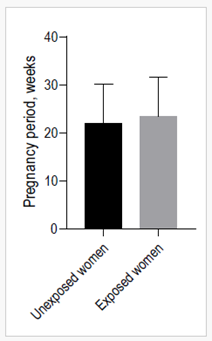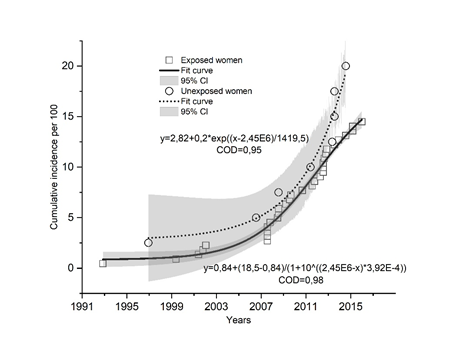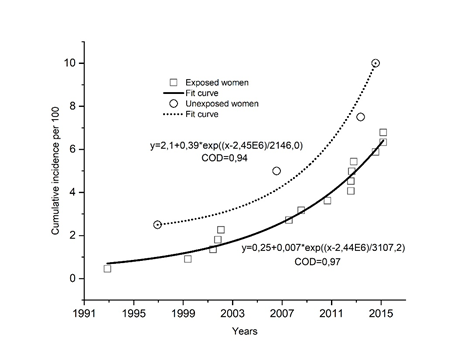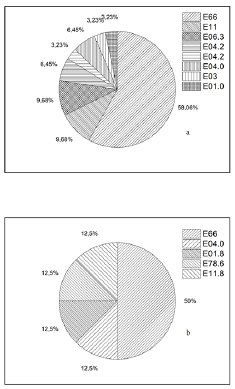Research Article 
 Creative Commons, CC-BY
Creative Commons, CC-BY
Endocrine Morbidity Among Women Exposed to Radioactive Iodine During Pregnancy
*Corresponding author: Alexander N Stojarov, Department of Radiation Medicine and Ecology, Belarusian State Medical University, 220116, Minsk, Belarus, Tel: +375297560223.
Received: February 11, 2025; Published: February 14, 2025
DOI: 10.34297/AJBSR.2025.25.003374
Abstract
In this publication, the long-term pathology associated with thyroid function in women who were pregnant in April 1986 and were exposed to radiation due to the incorporation of radioactive iodine as a result of the Chernobyl Nuclear Power Plant accident is analyzed. The comparison group consisted of women residing in the same region of Belarus but their pregnancies occurred after the decay of the radioactive iodine isotope. The age of the women in both groups at the time of pregnancy was 22-24 years, and gestational age was 21-23 weeks. The average absorbed dose due to the incorporation of radioactive iodine was 60-80 mGy. The incidence of endocrine system disorders in women was primarily represented by thyroid diseases, nutritional disorders, and metabolic disturbances (obesity). The cumulative incidence in the main group did not significantly differ from that in the comparison group. Based on the presented data, it is concluded that the identified pathology is of non-radiation origin and can be associated with an excess of stable iodine due to its intake from food and the use of iodine-containing medications during pregnancy.
Keywords: Radioactive iodine, Thyroid gland, Endocrine system pathology, Iodine-containing drugs
Abbreviations: TG: Thyroid Gland; ChNPP: Chernobyl Nuclear Power Plant.
Introduction
With this publication, we continue a series of studies dedicated to the analysis of pathology in various organs and systems of organs among women who, during April-May 1986, were at different stages of pregnancy and received thyroid irradiation due to the incorporation of radioactive iodine (I-131) released as a result of the Chernobyl Nuclear Power Plant (ChNPP) accident. A cohort of pregnant women was selected for the study for two primary reasons. Firstly, pregnancy is characterized by the overstrain of all physiological systems of the woman’s body, which ensure the development and growth of the fetus. This overstrain might largely influence the mechanism of action of the aforementioned factor. Secondly, there is significant interest in studying the health status of these women, as well as the morbidity of their offspring over extended periods of time. Previously, we analyzed the morbidity of the aforementioned women from 1986 to 2017 in relation to pathologies of the cardiovascular system [1,2], respiratory system [3], nervous system [4], and digestive system [5]. Interesting data were obtained regarding the phased nature of morbidity and the dose-dependent effects, which indicate the central, integrative role of the thyroid gland in the mediation of the effects of radiation on the human body and the development of systemic somatic pathology. In the present study, we conducted the analysis of endocrine system pathologies in women who were exposed to radioactive iodine during their pregnancy, compared to women who were not exposed to I-131 radiation during that period of life.
Materials and Methods
The study involved women who were at various stages of pregnancy during the initial days following the ChNPP accident and resided in the Stolin District of the Brest Region. Shortly after the accident, a radioactive cloud passed through this area, containing a wide range of radionuclides, including iodine isotopes (I-131, I-133, etc.). These isotopes entered the residents’ bodies through inhalation and ingestion, accumulated in the thyroid gland, and thus formed varying absorbed doses in this organ. The cohort of these women included 221 residents of the Stolin District, Brest Region.
As a comparison group, the study included women from the same Stolin District of the Brest Region whose pregnancies happened later, specifically in 1987. Due to the short half-life of I-131 (8 days), by 1987, iodine was nearly absent in the environment and no longer could affect the residents. However, the similar living conditions of the women in the Stolin District, the identical radiation exposure from the cesium-contaminated environment, and their comparable social status provided a solid basis for selecting this control group. The comparison group consisted of 40 women.
Data on morbidity were obtained from the State Registry of Individuals Affected by the Chernobyl Accident. The study utilized only data on refined diagnoses related to primary morbidity. Statistical analysis of the data was performed using specialized software packages: Statistics 10.0 (StatSoft Inc., USA) and SigmaPlot 12.5 (Systat Software Inc., Germany).
This study was approved by the Ethics Commission of the Belarusian Association of Physicians (10.12.2020).
Results and Discussion
In the studied cohort of women who were exposed to radioactive iodine and subsequently developed endocrine system disorders, nutritional disorders, and metabolic disturbances (class E00-E90 according to ICD-10), 32 cases of this pathology were recorded, accounting for 14.5% of the total number of affected individuals. The women in the selected cohort were at various stages of pregnancy at the time of the Chernobyl Nuclear Power Plant accident (April 1986). It is known that these periods are associated with specific stages of fetal development, which may result in varying sensitivity to the effects of radiation. This is particularly relevant during the first and second trimesters of pregnancy, when genesis of organs occurs in the developing fetus and the fetal thyroid gland (TG) is not yet functional. In this context, it was necessary to analyze the gestational ages in both the main and control groups (Figure 1). As can be seen, the average gestational age in the main and control groups did not differ significantly and was 21-23 weeks.

Figure 1: Gestational periods as of April 1986 for women in the main group and the control group (as of April 1987).
The primary dose range was within 60-70 mGy, and only onefifth of the women were characterized by significantly higher absorbed doses (> 80 mGy).
Analysis of the cumulative incidence of endocrine pathology revealed that the dynamics of the process in both the irradiated and non-irradiated groups of women over the period from 1996 to 2012 were nearly identical (Figure 2).

Figure 2: Cumulative incidence of endocrine pathology in the group of irradiated and non-irradiated pregnant women.
It is known that the specified class of diseases includes not only endocrine pathology but also nutritional disorders and metabolic disturbances. The analysis showed that the distribution of different types of pathology between the two groups differs (Figures. 3a and 3b). However, it can be noted that in both cases, a significant proportion of diseases are associated with metabolic disorders, i.e., obesity (E66). It can be assumed that the latter group of pathologies may not be related to the effect of the radiation factor. This is supported by literature data indicating uncertainty regarding the effect, i.e., whether the influence of thyroid hormones on the obesity process is dominant or, conversely, obesity affects thyroid functions [6]. In our previous studies, we hypothesized the role of thyroid hormone imbalance in the development of pathology depending on the activity of certain genes expression in thyrocytes. However, the consistent effect of obesity dominance in the morbidity structure is unlikely to be linked to the radiation factor. Nevertheless, it can be expected that this pathology may make its own contribution to the morbidity structure of the cohort. In this regard, at the next stage of the work, we analyzed the cumulative incidence in both groups of women without accounting for the contribution of obesity (Figure 4).

Figure 4: Cumulative incidence of diseases in irradiated and non-irradiated pregnant women excluding individuals with obesity (E66 according to ICD-10).
It is evident that the dynamics of disease incidence in both groups is similar. The slightly higher incidence rates observed in the non-irradiated group are not statistically significant. A detailed analysis reveals that among other types of thyroid pathology, both groups of women exhibit cases of non-toxic goiter (E04) and other thyroid disorders related to iodine deficiency (E01). Therefore, a preliminary conclusion can be drawn that the observed morbidity among residents of the Stolin district is of non-radiation origin. At the same time, the described changes cannot be attributed to the endemicity of the region in terms of stable iodine content in the environment, associated with insufficient iodine intake by the population, as available data indicate that iodine deficiency has already been overcome in Belarus [7]. Moreover, there is evidence of excessive iodine consumption among the population of Belarus [8]. This is due to the large-scale iodization of food products and the use of supplements in animal husbandry [9]. The use of iodinecontaining medications may also contribute to this.
Conclusion
Thus, radiation exposure during pregnancy due to the incorporation of radioactive iodine, paradoxically, does not significantly affect the structure and dynamics of thyroid disease incidence, unlike its effects on other body systems. It can be assumed that the altered morbidity we previously identified in various organs and systems of the body is due to the impact on them of the ratio of thyroid hormones level produced by the gland following radiation exposure, and the sensitivity of target cells to these hormones.
Conflict of Interest
Authors have no conflicts of interest.
Funding
This study did not receive any special grant from any funding agency in the government, commercial or non-profit sector.
References
- Stojarov AN, Khrustalev VV (2021) Cardiovascular Pathology in Women Who Received Radioactive Iodine Exposure During Pregnancy as a Result of the Chernobyl Accident. Biomed J Sci & Tech Res 27(2): 20320-29328.
- Stojarov AN, Khrustalev VV (2021) Essential Hypertension after Radiation Exposure. JSM Environmental Science & Ecology 9(1): 1-5.
- Stojarov AN, Khrustalev VV (2021) Delayed Consequences of the Radiactive Iodine Intake by Pregnant Women from the Site of Respiratory System. Am J of Biomedical Science and Research 15(2): 208-214.
- Stojarov AN, Khrustalev VV (2023) Delayed Pathology of the Nervous System in Women exposed to Radioactive Iodine During Pregnancy and their Children. Am J of Biomedical Science and Research 19(5): 567-569.
- Stojarov AN, Khrustalev VV (2023) Gastrointestinal Pathology in the Long-Term Period after Chernobyl Accident in Women exposed to Radioactive Iodine During Pregnancy. Am J of Biomedical Science and Research 19(6): 733-736.
- Thomas Reinehr (2010) Obesity and thyroid function. Molecular and Cellular Endocrinology 316(2): 165-171.
- Mohort TV, Kolomiec ND, Petrenko SV, Fedorenko EV, Mohort AG (2018) Dynamic monitoring of iodine sufficiency in Belarus: results and problems. Problems of endocrinology 64(3): 170-179.
- Yablonskaya IV, Zhavoronok SV, Stozharov AN (2020) Assessment of the level and structures of thyroid pathology in conditions of overcoming iodine deficiency. Medical journal 3: 120-125.
- Yablonskaya IV, Zhavoronok SV, Stozharov AN (2020) Assessment of the level and structures of thyroid pathology in conditions of overcoming iodine deficiency. Medical journal 3: 120-125.




 We use cookies to ensure you get the best experience on our website.
We use cookies to ensure you get the best experience on our website.